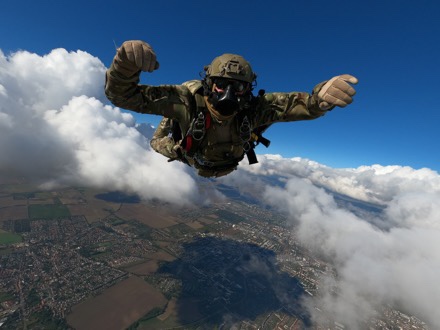Advanced technology provides advantages for special operations missions – enabling longer glide duration on higher altitude jumps, maximizing oxygen use and reducing system weight

TAMPA, FL (MAY 9, 2023) – Collins Aerospace, a Raytheon Technologies business (NYSE: RTX), introduced its OXYJUMP™ NG oxygen supply system for use in high altitude jumps by parachutists. The OXYJUMP NG system’s breakthrough technology enhances mission capabilities with a longer gliding distance, improves jumper safety, is easy to use and contains significant size and weight advantages over legacy systems.
Existing oxygen supply systems are limited in extended high-altitude operations, restricting the effectiveness and reach of parachute missions.
Utilizing Collins’ oxygen pulse technology – already certified by one NATO country – the OXYJUMP NG system provides customers with a smaller, lighter weight solution which automatically adjusts oxygen levels to enable longer mission profiles.
“The OXYJUMP NG system gives allied armed forces the stealth, readiness and safety necessary to complete the most complex jumps on earth,” said Brad Haselhorst, vice president and general manager of Military, Safety and Cargo Systems at Collins Aerospace. “The OXYJUMP NG system not only keeps up with the evolving nature of combat jumps, but it’s ready for use today.”
Designed for comfort and ease of use, the OXYJUMP NG system operates automatically and includes an ergonomically designed mask to comfortably and securely fit against the face, giving users peace of mind and keeping them focused on their most critical tasks.
Collins Aerospace’s OXYJUMP NG system will be on display at SOF Week in Tampa, Florida at booth L910.


Pretty cool example of dual use. I have a bit of experience with pulse regulators for medical use, they’ve come a long way in durability from the earlier mechanical versions like the Bonsai. Not at all uncommon to get over 30 hrs on a JumboD or E at 4l and they make the smaller bottles something useful .
I was reading an article by Ashley Rose McGuire on Subterranean Warfare and Low Oxygen Environments – could be a good thing if they took this and integrated it into a PAPR system.